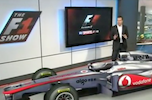Hego develops virtual F1 cars for Sky
 One of the innovations that Sky is bringing to its F1 coverage lies in being able to examine and dissect some of the more esoteric but vital technical nuances of F1 design thanks to virtual models of the grid supplied by Hego.
One of the innovations that Sky is bringing to its F1 coverage lies in being able to examine and dissect some of the more esoteric but vital technical nuances of F1 design thanks to virtual models of the grid supplied by Hego.
Hego has, of course, worked with Sky Sports closely over recent years to develop the touchscreens that are increasingly used by presenters on the broadcaster’s channels.
“In general, they’re a good medium for working with lots and lots of data, and of course F1 is a very data rich sport which was ideal for our touchscreen,” comments Hego’s Ian Wray. “We’ve also been dealing with virtual graphics for quite a number of years now, both traditionally using sensors where you have to understand the 3D environment you’re looking at, and also with sensor-less virtual graphics where you don’t need to move the camera round the 3D object.”
F1 cars are surprisingly small for such beasts of speed and thunder, and Sky has indeed got this season’s physical Red Bull into its dedicated F1 studio already this year. But doing that every time they want to flip a car over to talk about the technical details of its rear diffuser aerodynamics is somewhat impractical. Hence the virtual approach.
“One of the big challenges of this whole project was that the teams don’t release their cars until just before the season starts,” says Wray. “We couldn’t have done it with a half-hearted, generic approach, it had to be models of the 2012 cars themselves. So the project needed the buy-in from the teams and we needed another partner who could model them in a way that it would work in a realtime broadcast environment on our GS2 engine.”
To start the process, Sky was able to persuade the teams to provide CAD model files, which were then passed to motorsports specialist Q3DStudios for conversion into 3ds max models. These were then in turn finessed by Virtual Eye, who made sure the right textures and shaders were being used under the “virtual” studio lights, as well as apply a reflection map of the studio environment mapped onto the high polygon count model. Finally, Hego was able to project the finished model by connecting its GS2 engine to a sensor fitted camera and ensuring it was animated, highlighted and manipulated according to the editorial demands of the show. This included placing it correctly in the studio with corresponding shadows to ensure the realism was kept as high as maximum.
“It’s a constant trade-off between getting what looks as real as possible on the one hand without affecting the realtime performance too much on the other,” says Wray, “but we’re extremely happy with the results.”
As indeed they should be. The results are impressive and, if you haven’t seen what the system is capable of yet, have a look at the McLaren/diffuser sequence here:
